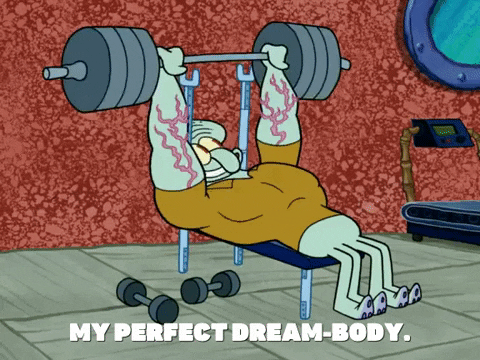Get Swole! Understanding Hypertrophy Training
FREE BODYBUILDING WORKOUT!
Download by entering below

How To Get Anabolic
Anabolic is freaking growth! Being anabolic, or understanding anabolism is using a metabolic process to stimulate some type of tissue growth. In this case, it is important to understand how to stimulate tissue growth in our muscles.
Hypertrophy
Let’s understand that there are three types of muscular-based hypertrophy. The first type we want to discuss is myofibrillar hypertrophy. Let’s think about how muscles are made up. In muscles, there’s going to be actin and myosin which lead to the sarcomeres. The sarcomeres lead to myofibrils. The myofibrils are then bundled into muscle fibers. The muscle fibers are then bundled into fascicles and the fascicles are then bundled into a giant muscle belly. With that Muscle 101 knowledge, we can see that myofibrillar hypertrophy is essentially increasing the size and/or the number of myofibrils.
The second form of muscle hypertrophy is sarcoplasmic hypertrophy. Sarcoplasmic hypertrophy is muscle hypertrophy that leads to an increase in the sarcoplasmic fraction of the muscle cell. Because of the sarcoplasmic fraction in the muscle cell, there is going to be an increase in the aqueous portion of the muscle cell, but there is not an actual increase in overall muscle fibers. The cell is going to swell. The swelling will lead to greater density or greater size of the actual muscle.

The third form of hypertrophy is connective tissue hypertrophy or the fancy name, extracellular matrix hypertrophy. Our muscle mass is made up of about 20% of our connective tissue. If we can increase the size of the ligaments and tendons in our joints, it becomes the foundation of our overall performance. Doing sets of 50 or 60 reps of leg presses or squats can work. Low-level plyometrics for tons of reps can also be used to stimulate connective tissue hypertrophy. For instance, doing copious amounts of bunny hops will stiffen the ankle joint to allow for more elastic energy to be stored.

Role Of Hormones
Understanding hormones and the roles they play in helping muscle protein synthesis is important to grasping being anabolic. That means recognizing and comprehending the impact that IGF-1 has in the process. Specifically, the impact of IGF-1 EB and IGF1 EA.
One of the key things I learned from Professor Steven Cornish is how muscles interact with one another and how they interact with the body. Understanding that IGF-1 is used in myofibrils to stimulate satellite cell proliferation. For instance, if there is an increase in nitric oxide or some muscle damage, the myofibrils will signal to stimulate and proliferate satellite cells to donate myonuclei. The myonuclei will help the body get stronger, more hypertrophic, and more anabolic.
I like to look at IGF-1 as a hypertrophic sensor. While doing resistance-based training, hormones like IGF-1 E and IGF-1 EC (also known as mechano growth factors) are stimulated as well. Mechano growth factor enhances muscle protein synthesis; it also somewhat debunks the 30-minute window of having protein because after doing resistance-based training, MGF is elevated for 36 to 48 hours. That means that in that window, as long as enough protein is being digested, the body will be anabolic and will see greater muscular gains.

Muscular Anabolism
As Brad Schoenfeld pointed out, there are three key ways to stimulate muscular anabolism.
1. Mechanical Tension
Mechanical tension puts forces on the sarcomeres. That then leads to mechanoreceptors that then activate a specific response inside the muscular cell. On top of that, this is all regulated by myogenic pathways.
2. Metabolic Stress
Metabolic stress is going to be more specific towards a type of energy system, which in this discussion is going to be anaerobic glycolysis. Anaerobic glycolysis is going to typically happens after about 15 seconds of training and last up to 2 to 3 minutes; it will not last longer than three minutes. This adaptation is going to occur from metabolite-induced fatigue. If I am doing a set of 15 to 20 reps, my body and muscles will experience that metabolite-induced fatigue. The metabolite-induced fatigue will lead to cell swelling and, over time, is going to lead to hypertrophic gains.

One big factor we have to understand is the importance of having more time under tension, as well as longer duration sets, leading to metabolic adaptation from metabolic stress. That’s where something like BFR comes into play. Blood flow restriction is so effective because it induces metabolite fatigue.
3. Muscular Damage
Muscular damage stimulates muscular anabolism. Muscular damage is dependent on a few factors. Factors like the type of moving being performed, how long it has been done since the movement has been performed, the intensity of the movement, or the type of action, like a slow eccentric which will all lead to the wanted adaptation.
Continually Improving Anabolism
It begins with eating more protein and sleeping more effectively.
To make sure the body can use the right hormones to stimulate the anabolic response, we need to make sure our nutrition is on point, like eating healthy almonds.
Sleep also plays a massive role in muscular anabolism. Make sure to get 8 to 10 hours of sleep every single night, especially after a hard day of training.
Recap
Want a deeper dive into all of this? Read Brad Schoenfeld’s “Science and Development of Muscle Hypertrophy” and go all in because he goes deep into all of these topics more than I can in a blog.
That said, in this blog, we defined what anabolic means and talked about the three types of hypertrophy. Remember, the three types of hypertrophy are sarcoplasmic hypertrophy, myofibrillar hypertrophy, and extracellular matrix hypertrophy (which is hypertrophy around the joints). We went over how hypertrophy is stimulated in the hypertrophic sensors–think about the mechano growth factor. Don’t forget MGF! Finally, remember to eat 1 gram of protein per pound of body weight and sleep for 8 to 10 hours a night to get anabolic.
Related Posts
Blog Topics

Yo, It's Dane
Welcome to the Garage Strength Blog, where it is my goal to provide you with the experience and knowledge I've gained in the strength and conditioning world over many years of learning from both successes and failures. I train elite-level athletes in a multitude of sports from the high school to professional levels, already producing 5 Olympics and 30+ National Champions. If you want to be the next champion I train, check out my strength programs below!
Start Training With Me

Join for free educational videos EVERY WEEK on strength coaching and athletic performance



